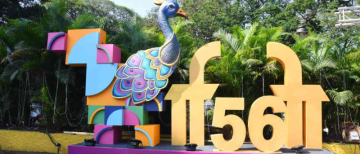As the 2025 Maha Kumbh Mela unfolds in Prayagraj, the confluence of the Ganga and Yamuna rivers is once again at the center of a significant cultural and religious event. However, this gathering of millions raises pressing concerns about the ecological health of these sacred waters.
Environmental Challenges
The National Green Tribunal (NGT) has mandated that the Uttar Pradesh government and the Central Pollution Control Board (CPCB) ensure that no untreated sewage is discharged into the Ganga and Yamuna during the event. This directive comes in response to projections that sewage generation could increase by 10% during the festival, potentially leading to a discharge of approximately 519 million liters per day (MLD) into these rivers.
With only about 450 MLD expected to be treated at existing sewage treatment plants (STPs), concerns about water quality remain paramount.
Historically, mass bathing during Kumbh Mela has been linked to a spike in pollution levels. For instance, during previous events, studies indicated alarming increases in biological oxygen demand (BOD) levels in the Ganga, with some measurements reaching as high as 250 mg per liter.
The sheer volume of pilgrims—estimated to reach 100 million over the course of the festival—exacerbates these issues, as each individual contributes to waste generation that overwhelms local waste management systems
The Other Side: Efforts for Cleanliness
In light of these challenges, authorities are implementing measures aimed at mitigating environmental impacts. The NGT's recent orders include increasing monitoring points along the rivers and ensuring regular water quality testing.
Additionally, there are efforts to manage solid waste generated during the event, which includes food packaging and other non-biodegradable materials that can further pollute the rivers
While temporary solutions have been put in place—such as enhanced sewage treatment capabilities during the Kumbh—the long-term effectiveness of these measures remains questionable. Critics argue that despite these efforts, the Ganga continues to suffer from chronic pollution issues exacerbated by large gatherings like the Kumbh Mela.
Cultural Significance vs. Ecological Integrity
The Kumbh Mela is not just a religious event; it represents a deep-rooted cultural tradition for millions of Hindus who believe that bathing in these sacred waters can cleanse sins and provide spiritual salvation. However, this ritualistic cleansing paradoxically contributes to ecological degradation. The influx of pilgrims leads to increased fecal contamination and various pollutants entering the river ecosystem, which can harm aquatic life and disrupt local biodiversity.
Moreover, infrastructure development associated with such large events often leads to habitat disruption. Increased noise pollution and construction activities can damage riverbanks and spawning grounds for fish, further threatening aquatic biodiversity.
Conclusion
As Prayagraj prepares for the Maha Kumbh Mela, it faces a critical juncture between honoring a cherished spiritual tradition and safeguarding the ecological health of its revered rivers. While authorities are striving to implement measures to protect water quality, the ongoing challenges posed by untreated sewage and waste management highlight a need for sustainable practices that respect both cultural heritage and environmental integrity. The success of these efforts will not only determine the immediate health of the Ganga but also set a precedent for future gatherings that celebrate faith amidst ecological responsibility.
How do sewage treatment plants handle the increased waste during the festival?
Sewage treatment plants (STPs) are crucial in managing the increased waste generated during large events like the Maha Kumbh Mela. As millions of pilgrims gather, the volume of sewage produced can significantly exceed normal levels, necessitating efficient and effective treatment processes.
Handling Increased Waste During the Festival
- Preliminary Treatment:
- STPs begin by screening incoming sewage to remove large debris such as rags and sticks. This step is essential to prevent damage to equipment and ensure smooth operation during peak loads.
.
- STPs begin by screening incoming sewage to remove large debris such as rags and sticks. This step is essential to prevent damage to equipment and ensure smooth operation during peak loads.
- Primary Treatment:
- After screening, sewage flows into sedimentation tanks where solids settle at the bottom. This process can remove up to 60% of solids from the wastewater, allowing clearer water to move on to the next stages.
.
- After screening, sewage flows into sedimentation tanks where solids settle at the bottom. This process can remove up to 60% of solids from the wastewater, allowing clearer water to move on to the next stages.
- Secondary Treatment:
- This stage employs biological processes where microorganisms break down organic matter. Aeration tanks introduce air to support aerobic bacteria, which consume pollutants, converting them into carbon dioxide and water
. The treated water is then clarified to separate remaining biomass from the liquid.
- This stage employs biological processes where microorganisms break down organic matter. Aeration tanks introduce air to support aerobic bacteria, which consume pollutants, converting them into carbon dioxide and water
- Tertiary Treatment:
- In many cases, especially during festivals, a tertiary treatment stage is implemented to further purify the water before discharge. This may involve advanced filtration or chemical treatments to ensure that the water meets environmental standards for safe release back into the Ganga or Yamuna rivers.
Enhanced Capacity and Infrastructure
To accommodate the surge in waste during the Kumbh Mela, STPs often increase their operational capacity temporarily. This could involve:
- Deploying Mobile Treatment Units: These units can be set up quickly to handle additional sewage loads without overburdening existing facilities.
- Collaboration with Local Authorities: STPs work closely with event organizers and local governments to anticipate waste generation patterns and adjust their operations accordingly.
Challenges and Solutions
Despite these measures, challenges remain:
- Infrastructure Limitations: Many STPs may not be equipped to handle sudden spikes in wastewater volume effectively.
- Public Awareness: Ensuring that festival-goers are aware of proper waste disposal practices is vital in reducing the overall load on sewage systems.
In summary, STPs play a critical role in managing increased waste during large events like the Maha Kumbh Mela through a series of structured treatment processes. By enhancing capacity and infrastructure while promoting public awareness, these plants aim to mitigate the environmental impact on sacred rivers like the Ganga and Yamuna.
With inputs from agencies
Image Source: Multiple agencies
*The views expressed are personal to the author and do not reflect the platform's opinion of the same.
© Copyright 2024. All Rights Reserved Powered by Vygr Media.
























